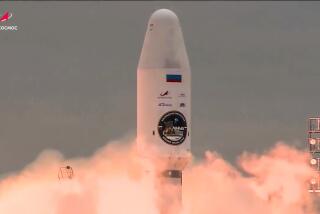Experimental Orbiting Mirror Reflects Russian’s Ingenuity
- Share via
MOSCOW — A few months from now, an object will appear suddenly in the night sky and unfold glistening panels like an insect unfurling new wings.
Slowly it will rotate and aim a blinding ray at the Earth. The beam will roam over the globe’s surface, seeking out population centers: southern Europe, Houston, maybe Los Angeles.
Aliens? Madmen? No, just the latest from the Mir space station.
In a project that seems to borrow equally from James Bond and Flash Gordon, the Russians are preparing to place a huge mirror in orbit about 230 miles above the Earth.
Some call the plan visionary. Others call it demented.
“It’s a completely crackpot idea,” says Terence Dickinson, editor of the astronomy magazine Skynews.
The man behind the mirror is Vladimir Syromyatnikov, a veteran Soviet space engineer whose career began before Sputnik was launched in 1957.
His dream is to learn how to beam sunlight into the frozen expanses of northern Russia, where light-deprived residents struggle through the winter on an hour or two of watery daylight and frequently suffer ailments such as depression and alcoholism.
The space mirror--named Znamya, or Banner--was launched to the Mir space station Sunday on a cargo ship. When it is deployed sometime in February, the 82-foot-diameter, aluminum-coated plastic mirror will make 16 orbits, casting down a shaft of sunlight about 1 1/2 miles wide at the surface, before falling back toward Earth and burning up in the atmosphere.
Cosmonauts will aim the beam at various points lying approximately between 30 and 40 degrees latitude north. One likely target will be the Johnson Space Center in Houston. And because much of California is in that range, Syromyatnikov says there’s a good chance that the southern part of the state will get a dose.
If the sky is clear, those lying in the path will be bathed in light between five and 10 times brighter than the moon--enough to read a newspaper.
Eventually, Syromyatnikov says, a whole necklace of such mirrors could be slung around the Earth, keeping cities in Russia’s far north in a welcome, solar glow.
Dickinson and other critics say the concept has more holes than there are craters on the moon.
For one thing, Dickinson says, with the mirror flying past at 17,000 mph, it’s practically impossible to keep it trained on a fixed target below. For another, reflected sunlight will never be strong enough to mimic the sun.
And that’s not to mention scenarios of ecological havoc: polar icecaps melting, animals coming out of hibernation or seeds sprouting in midwinter.
However, even Dickinson acknowledges that the mirror has one potentially invaluable application that at first sounds even more farfetched: interplanetary travel.
The concept is unnervingly simple.
In the vacuum of space, the force of photons, or high-energy particles, of sunlight bouncing off its reflective surface is enough to propel a mirror through space. Theoretically, a mirror could travel infinite distances as long as it had a light source.
James Oberg, a U.S. space expert often critical of the Russian space program, says Syromyatnikov and his team deserve praise.
“It’s amazing that in the depths of their poverty, they still find the time to do something farsighted like this,” he says.
More to Read
Sign up for Essential California
The most important California stories and recommendations in your inbox every morning.
You may occasionally receive promotional content from the Los Angeles Times.













